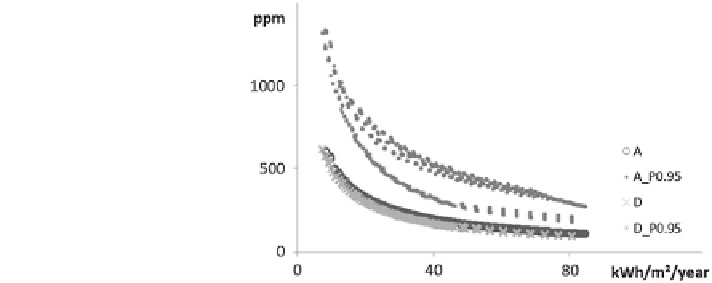Civil Engineering Reference
In-Depth Information
3.3 System
A last set of modifying factors is imbedded in the ventilation system. Its charac-
teristics will determine the energy required to deliver a predefined ventilation flow
rate. This energy contains both the energy required to condition the air to
acceptable temperatures and that to move the air (Orme
1998
; Santos and Leal
2012
). Other associated costs are investment costs and maintenance (Blom et al.
2010
).
The layout of the supply and exhaust vents not only influences the flow field in
the ventilated space, but can also have a significant impact on the duct configu-
ration and thus on the total pressure drop in the system. The latter is exponentially
related to fan energy required to provide the desired flow rate in fan driven systems
and determines the achievable flow rates in systems relying on natural driving
forces such as wind and buoyancy. The performance of systems relying on natural
driving forces is less robust due to the variability of these forces (van Moeseke
et al.
2005
; Ji et al.
2011
; Gładyszewska-Fiedoruk and Gajewski
2012
).
Figure
2
shows the optimal ventilation heat loss/exposure to carbon dioxide
trade-off in a detached dwelling in Belgium (Laverge et al.
2013b
; Laverge and
Janssens
2010
) for both purposely designed natural ventilation systems (A) and
mechanical ventilation (D). For each system type, the pareto optimal sizing
options were selected from 8,000 individually simulated sizing options. Although
the optimal mean exposure is virtually the same for both systems, the peak
exposure, defined here as the 95 % percentile of the distribution of the exposure, is
much higher for the natural ventilation system. Adding components such as
pressure-regulated trickle ventilators (CEN
2004
; Karava et al.
2003
), (solar)
chimneys (Khanal and Lei
2011
; Prajongsan and Sharples
2012
) and wind cowls
(van Hooff et al.
2011
; Montazeri, Pfeiffer et al.
2008
) helps achieve more stable
airflow rates.
Fan-supported ventilation provides more robust indoor air quality, but requires
fan energy (Nilsson
1995
; Liu and Liu
2012
). This introduces the conversion
between heat loss and electrical power consumption as an additional dimension in
Fig. 2 Pareto optimal mean
exposure (ppm) versus
ventilation heat loss (kWh/
m
2
/year) in a Belgian
detached house for natural
(A) and mechanical
(D) ventilation, with
associated peak exposures
(P
0.95
)

